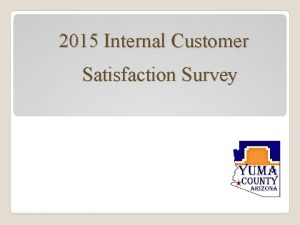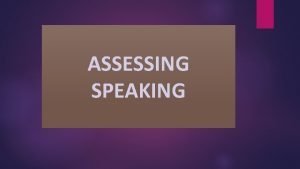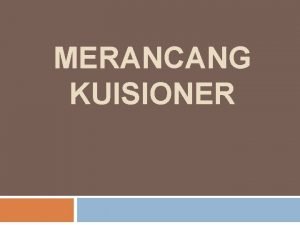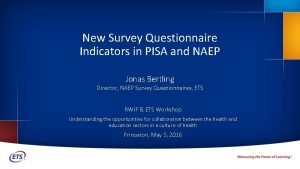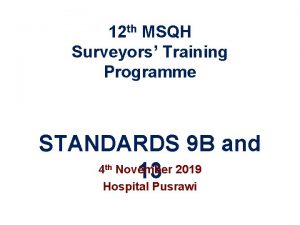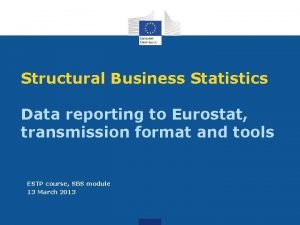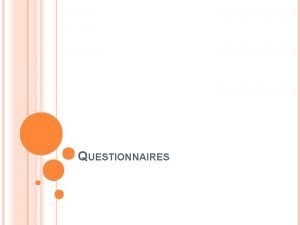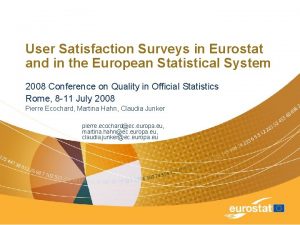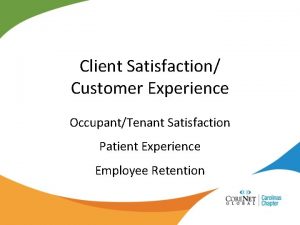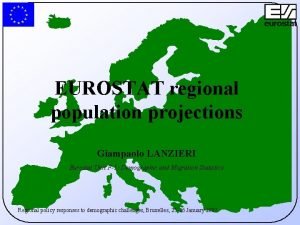Eurostat experience with staff satisfaction questionnaires and surveys











- Slides: 11

Eurostat experience with staff satisfaction questionnaires and surveys Workshop on Human Resources Management and Training, Geneva, 14 -16 September 2010 Claudia Junker, Eurostat Claudia. junker@ec. europa. eu

Agenda n Introduction and context of Eurostat staff opinion surveys (SOS) n History of Staff opinion surveys at Eurostat n Questionnaire design n Stakeholders n Promotion activities n Survey implementation aspects n Analysis of the results / Follow-up of the results n Lessons learnt

Introduction and context of Eurostat SOS n Reasons for implementing SOS n Management Plan of Eurostat – Objective 4: boosting staff motivation n Evaluation of staff performance – measurement of staff satisfaction n Tool for top management

History of Eurostat SOS n First SOS – 1999 (full survey, long questionnaire) n Concept: full survey every 2 nd year n Second SOS – 2001 (light survey, shortened questionnaire) n Third SOS – 2002 (full survey, long questionnaire) n Break n Fourth SOS – 2005 (full survey, long questionnaire) n Fifth SOS – 2006 (light survey, shortened questionnaire) n Sixth SOS – 2007 (light survey, short questionnaire) n Seventh SOS – 2009 (full survey, long questionnaire)

Questionnaire design (1) n n Collected experience from other offices in 1999, 2009 Establishment of an internal steering committee Reflection on internal needs for the management Basic principles – Minimum but sufficient identification of staff for later analysis – Burning issues – Willingness of staff to answer – Issues that can be treated at Eurostat level – Informal agreement of top management – Some kind of stability for comparison of results

Questionnaire design (2) n Blocks of questions (5 -7) – – Basic questions about the person Statements about the job Statements about the management Statements about the organisation relationship/working conditions/working arrangements – Statements about general support services – Statements about the follow-up of the results from the previous SOS n Number of questions (70 -130) n Answering options n Adjustments to new reality

Stakeholders n SOS coordinator n Internal steering committee – Mix of departments, languages, nationalities, gender, status, grade – Sufficient number of colleagues – Voluntary membership n Top management n Sponsor

Promotion activities n Intranet of Eurostat – – n n n Message on usefulness Message on improvements since last survey Message for different staff members Message on confidentiality of replies Posters in the building Leaflets Messages and reminders from hierarchy Personal e-mail from director general Specific logo 1 st day and last day promotion at the entrance

Survey implementation aspects n n n n Complete count Response rates Standard electronic tool Confidentiality of replies Single access to results Press release on response rates Easy access to the questionnaire Questionnaire in 3 languages

Analysis of the results / follow-up n n n n n Processing of the results by the SOS coordinator Different breakdowns available Comparison with previous results, if possible Presentations at the level of Eurostat to the top management Presentations at the level of directorates (7) – obligatory Presentations at the level of units (42) – upon request Top management discusses results and follow-up on the basis of proposals from the coordinator 2009 follow-up delegated to the level of directorates Some follow-up activities done

Lessons learnt n Balance between top-down approach and pure staff initiative is needed (ownership of the survey) n Useful tool for the management if properly followed-up n Confidentiality of replies – burning topic since many years n Follow-up measures are crucial for the success n Timing and frequency of surveys can have an influence on the implementation and results n Promote an exchange of experience? n Good practices?
 Internal customer satisfaction surveys
Internal customer satisfaction surveys Basic types of speaking
Basic types of speaking Interviews and questionnaires
Interviews and questionnaires Unstructured questionnaire examples
Unstructured questionnaire examples Pisa
Pisa Lecture automatique de questionnaires
Lecture automatique de questionnaires Msqh survey questionnaires
Msqh survey questionnaires Questionnaires about vaal river
Questionnaires about vaal river What is indirect experience
What is indirect experience Imprinting meaning psychology
Imprinting meaning psychology Early experience vs later experience debate
Early experience vs later experience debate Eurostat sbs
Eurostat sbs
